Which are the best castles to visit in Wallonia? We found 5 very different castles that all tell their specific tale about the nobility of the past, the architectural advances over the years, the chores of the servants and the history of this part of Belgium. Join us in discovering our Top5 Wallonia castles.
A visit to a castle usually has something interesting for everyone in the family; lots of charm, spooky dungeons, luscious furniture, fascinating ancestral tree and history. And while many castle answers most of our questions, there are lots of questions unanswered as well:
How cold was it inside in wintertime? How much did it smell when you peed down the castle walls? How heavy and hot was it to fight in that armour?
Our imagination is tickled; we see princes of bygone eras practising sword fight in the courtyard, the ladies reading in the hall in front of the roaring fireplace, the staff sweating over the pots in the kitchen.
History becomes alive.
We found 5 very different castles in Wallonia, the southern part of of Belgium: one fairytale castle, where Sleeping Beauty is dreaming her days away, another is called “the Versailles of Belgium”, a third is a medieval and private castle, the fourth is famous for and surrounded by a beautiful garden and the fifth has 3 museums and a moat.
Let’s have a closer look at these 5 very different castles – with a map of them at the end:
Chateau de Veves
Chateau de Veves is the castle of the sleeping beauty. And to keep the promise you make with such a statement, all little princes and princesses can borrow costumes, dress up and become royal for a day.
Rooted in medieval times, this small and yet majestic castle was the stronghold of Pepin de Herstal in the 8th century and from the 12th century and onward for the Counts of Liederkerke Beaufort, a family that still owns this fairy tale castle and others in the area.
A large hall – the size of the castle taken in consideration – takes your breath away as you enter the first floor. Ancestral tree of family, politics and religion dating back to year 0 can be studied on the far side wall and the floor tells its own tale of dances, banquets and heavy use. Most other room are furnished in the 18th century and show exquisite porcelain and historic curiosities. The visit inside ends after a walk through the old kitchen, wondering what the crevices by the kitchen window was used for, but you can stay and linger outside at the nice terrasse café (open July 15th – August 15th) with a cup of chilled cider or local beer and majestic views.
Chateau de Beloeil
The grand castle of Chateau de Beloeil is also called “Belgium’s Versailles” and is the most stately of the 5 castles we visited. Just walking towards the palatial building is impressive. The comparison may be somewhat of an exaggeration, but the grandeur is real and the history royal.
Like many other castles is began its life in medieval times and has over the last 800 years been turned into a more comfortable home to the Princes de Ligne. In the end of the 14th century, the Ligne family inherited the castle and only made some minor adjustments to the fortress in the beginning. The family became Imperial counts on 18 December 1544 , created the beautiful baroque garden in 1664 and added two wings to the castle in 1665. In the 18th century – at the height of French decadence and style – the castle was turned into its present form and furnished sumptuous.
While much of the castle unfortunately burnt down during the New Year celebration in 1900, the furniture and large book collection was unharmed and the castle was rebuilt to its former glory. Today you can walk through the luxurious rooms, admire the large 17th century tapestries and the well-preserved Louis XVI furniture. The height of the visit for us was the Old Library, founded in the 17th century with a collection of more than 20.000 books dating from the 14th to 19th century. What a treasure!
The garden no longer has its baroque appearance or extravagance, but you can walk along the long lake and let your imagination paint the greenery more extravagant.
Corroy le Chateau
The medieval castle of Corroy le Chateau is a true treasure and one of the most well-kept examples of medieval fortresses. Yes yes, we know that all the other castles we’ve presented so far all have their roots in medieval times, but this one hasn’t changed its outer appearance.
You can still admire the medieval towers and walls and furthermore see, where the guards did their rounds up on the castle walls, the blocked up doors and pathways of this old fortress.
A visit to this castle is a whole other ballgame than the other castles. This one is private. Only open from May to September on weekends and public holidays, and only with a private guide, since the castle is still inhabited by the 15th marquis de Trazegnies. This makes the visit a private and intimate experience.
We stood in front of the imposing gate at the chateau who looked and sounded empty and read the sign: “Ring here, if the guide doesn’t show up after two minutes, ring again. If he still doesn’t show up, he is finishing another tour. In that case, please wait.” We pulled the chain (yes, yes – it was a medieval bell as well) and waited. We heard footsteps on the cobble stoned courtyard and an elderly gentleman answered the door. The marquis himself. He explained that the guide would be with us momentarily and we had only wait a few seconds before she came and started explaining everything about the castle. The guide – who speaks English very well despite her denial – had a profound knowledge of the castle, history, furnishings and accessories. She could answer all our questions and show us the tangible evidence of how the medieval use of this castle still affects the modern-day life in an old castle.
A real intimate gem, that provides a great contrast to the other castle visits.
- Corroy le Chateau website (in French)
Jardins et Chateau d’Annevoie
Alright, this may be more a garden than a castle (which you can’t even visit) but we did promise you 5 very different castles, right? The gardens and castle of Annevoie, which are a major Heritage site in Wallonia, boast 4 springs, 48 hectares of park, 50 water features, 200 year old trees and 250 years of water flowing through the gardens.
The fountains, springs and streams are all powered by nature, relying solely on the different levels of the estate and the water pressure, it can therefore deliver. No machines are used for creating any of the 50 water features. That in itself is a feature! Through underground canals the water runs through the gardens and animates the fountains in the 3 different garden styles:
Italian Style: Art adapts to nature
The style, which originated from Tuscany in the late 15th century, is characterised by planting beds laid out symmetrical patterns and typified by eg. the Boboli gardens in Florence. The gardens were designed to represent harmony and order.
French Style: Art corrects nature
While the French Renaissance garden originated from the Italian and was similar in style, it evolved from being a separate entity, not integrated with the architecture of the chateau to be an integral part of the chateau’s representation. The Gardens of Versailles, created between 1662 and 1700, were the greatest achievement of the French Style Garden. The garden represent perfect symmetry and demonstrates man’s mastery over nature.
English Style: Art imitates nature
Any fashion gets a backlash. As with the formal and symmetrical gardens of Italy and France, there emerged a longing for at more natural garden. In the early 18th century, English landscape designers strove to create an ideal landscape out of the English countryside. For the first time, the form of a garden was inspired not by architecture, but by an idealised version of nature.
All 3 garden styles are represented in Jardins d’Annevoie and make it an interesting and educational visit. Parts of the Chateau originate from 1627 and curve slightly along the Rouillon valley. Just another perfect example of the 16th century Italian garden, where Art adapts to Nature.
Chateau de Lavaux Sainte-Anne
The imposing Chateau de Lavaux Sainte-Anne is 1 castle and 3 museums all in one elegant package! Entering the premises through the former farm house next to the castle, the huge medieval towers are an imposing sight to behold.
We walk towards the Renaissance doorway, over the bridge and into the courtyard of this three-winged castle, that opens up towards to other side, overlooking the moat and the nearby wetlands. Although the tower was built as long ago as the 13th century as a lookout post over the old Roman road, it wasn’t until 1450 that it became a real castle, with dungeons, moat and everything.
We start the visit inside the castle and enter many historic rooms, all part of the first museum, displaying the history and life of the 17th and 18th century lords of Lavaux-Sainte-Anne that lived and entertained in this grand residence.
The second museum in the cellar contains a collection that illustrates the country life in the Famenne region in the 19th and early 20th century. Old agriculture gear, tools for processing food and spin the wool are exhibited in the rooms, where they very much seem at home, blending in with the large fireplaces and stone floors.
The third museum inside the castle walls and on the 1st floor informs about the natural history of Famenne, displays many stuffed animals and information about hunting techniques, with a whole room dedicated to falconry.
Outside the castle, you can walk though the wetland, that has both pond, marsh and meadow. The recently established area is a haven for plants, insects and birds and is a pleasant 20 minute stroll.
More info:
Or if you’re visiting Belgium and are looking for a guide to hiking and biking or want to sample the wonderful abbey and trappist beer, check out those articles!
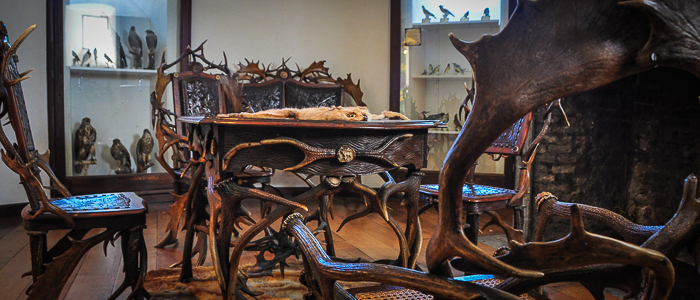
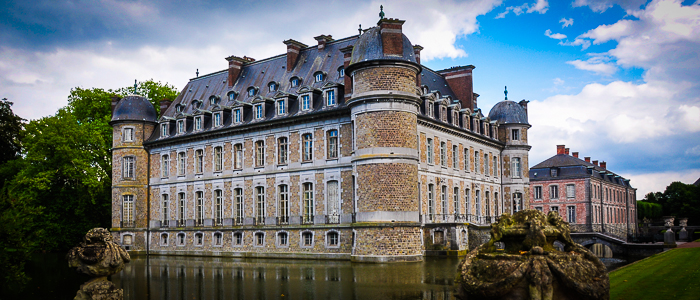
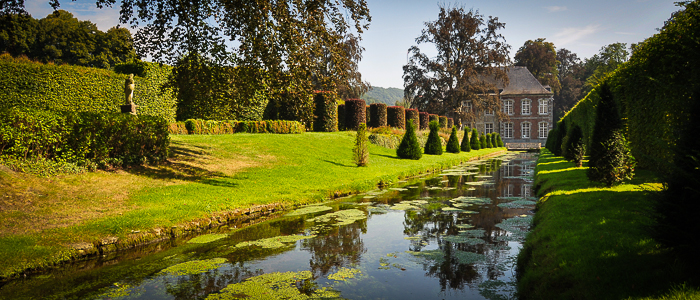


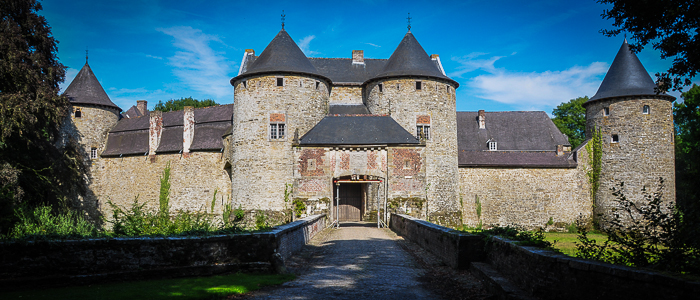










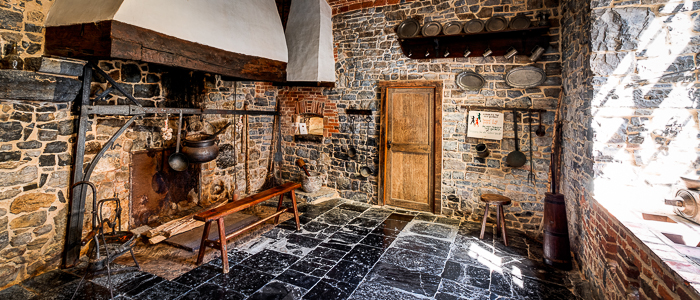

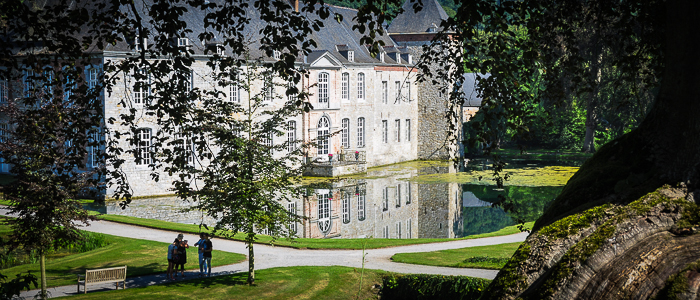



The castles of Vêves, Annevoie and Lavaux-Sainte-Anne are all close to Dinant